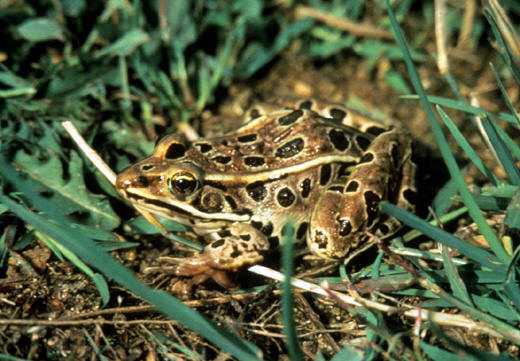Nutrition
 The
northern leopard frog is considered to be an opportunistic
feeder, which means they sit and wait for their prey to come to
them. Their diet mostly consists of insects, such as
damselflies, but they have been found to eat
worms,
snails, slugs, and smaller frogs such as the
Spring
Peeper. The tadpole form of the northern leopard frog
eats plant tissues and bacteria from a plant by scraping their
mouth over the plant surfaces.
The
northern leopard frog is considered to be an opportunistic
feeder, which means they sit and wait for their prey to come to
them. Their diet mostly consists of insects, such as
damselflies, but they have been found to eat
worms,
snails, slugs, and smaller frogs such as the
Spring
Peeper. The tadpole form of the northern leopard frog
eats plant tissues and bacteria from a plant by scraping their
mouth over the plant surfaces.
 The
digestive system in Rana pipiens first begins at the mouth of the
organism. Inside the mouth this frog does have teeth inside the
upper jaw, these are used to grid its food before swallowing and
digestion. These teeth are not very strong, so they do not assist
them in the capture of prey. The food then travels down the
esophagus and into the stomach. After reaching the stomach, the
food then travels to the small intestine where most of the digestion
takes place to absorb the nutrients. The ruminants then move
through the large intestine and out the cloaca and excreted as
waste. The cloaca (in Latin means “sewer”) is the opening where
both urine and feces are excreted. Cloaca are present in all
amphibians, birds, and reptiles.
The
digestive system in Rana pipiens first begins at the mouth of the
organism. Inside the mouth this frog does have teeth inside the
upper jaw, these are used to grid its food before swallowing and
digestion. These teeth are not very strong, so they do not assist
them in the capture of prey. The food then travels down the
esophagus and into the stomach. After reaching the stomach, the
food then travels to the small intestine where most of the digestion
takes place to absorb the nutrients. The ruminants then move
through the large intestine and out the cloaca and excreted as
waste. The cloaca (in Latin means “sewer”) is the opening where
both urine and feces are excreted. Cloaca are present in all
amphibians, birds, and reptiles.
Go Home, or continue to learn more about the Reproduction/Life Cycle of the Northern Leopard Frog.
Back to http://www.multipleorganisms.net

